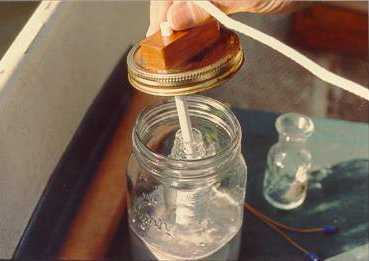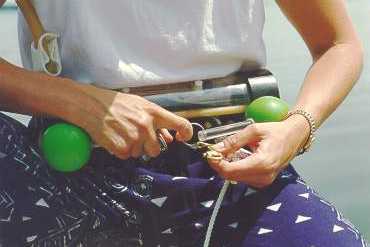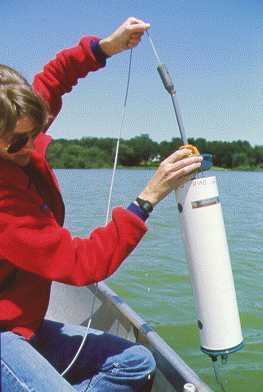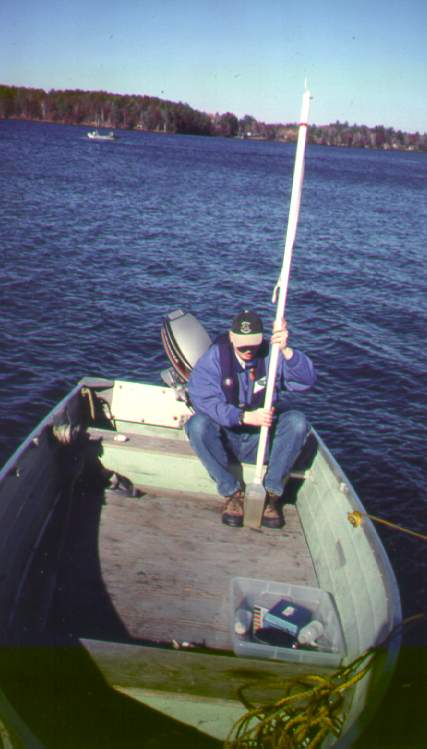Wisconsin Citizen Lake Monitoring History
Wisconsin's Citizen Lake Monitoring Network (formerly called "Self-Help Lake Monitoring"
began in 1986 with 126 lakes monitored for water clarity by interested and active citizen
volunteers. In the first 15 years, over 2400 volunteers have participated in the program,
and have monitored over 1000 different lakes. Currently, the program has grown to include
over 1100 active volunteers monitoring over 850 lakes. These citizens have learned a lot
about their lakes and a substantial database has been established from their sampling efforts.
Published data appears in numerous reports and is used by limnologists and water resource
planners for a variety of purposes.
In 1990, volunteers were given the opportunity to get involved in more extensive lake
sampling. Citizen Lake Monitoring now includes several sampling groups. Secchi volunteers
collect basic water clarity information of their lakes. Chemistry volunteers collect water
clarity data as well as temperature, chlorophyll, phosphorous, and dissolved oxygen data. This
allows DNR managers to assess the state of nutrient enrichment in their lakes. Biological
monitoring activities include zebra mussel monitoring, Eurasian water milfoil watch, purple
loosestrife monitoring, and other aquatic plant monitoring.
At the end of each sampling season, volunteers receive reports that outline their lake's
data from the past year, as well as every other year that lake has been sampled, either by
them or a different volunteer. The reports include an Annual Report, which is a summary of the
data and observations they recorded, a graph of their Secchi depths, as well as the previous
year's depths, and finally a Trophic State Index graph that tells the volunteer where their
data points fall in relation to the approximate Trophic State of lakes.
Equipment
There have been changes in the equipment Citizen Lake Monitors have used. This page
will give you detailed information on each sampling device. Volunteers have been
collecting chlorophyll, phosphorus, temperature, and dissolved oxygen on their lakes
since 1990. These parameters are necessary to determine a Trophic State Index value
for their lake. The sampling takes an average of about 3-4 hours and involves not
only on-lake procedures, but also taking samples back home for processing and mailing
the phosphorus and chlorophyll samples to the State Lab of Hygiene in Madison. We
thank the volunteers that have dedicated their time to take these water samples!
Mason Jar
1990-1992

Mason Jar sampler
We can thank one of our regular Secchi disc volunteers for the ingenious "Wisconsin
Self-Help Monitoring Water Sampler." Paul Anderson, native to Madison, is the inventor
of the Mason Jar.
The water is collected with a simple device - an ordinary Mason jar - with a few
adjustments. The jar is filled part way with cement to make it heavy. The lid is
equipped with two tubes - one to let water in and one to let air out. The tubes
are stoppered and with the lid screwed on, the jar is lowered to whatever depth
is necessary. At that point, the volunteer pulls on the stopper cord and "pulls
the plugs," allowing that water to go in one tube and the air that was in the jar
is forced out. When you are sitting in the boat, all you see are air bubbles rising
to the surface. When the bubbles stop, you know that jar is full!
When the full Mason jar is hauled to the surface holding water from a specific depth,
the work begins. Volunteers begin the test to determine how much dissolved oxygen
is in the water.
Two phosphorus samples are also collected: one 1 foot below the top of the lake
and one 1 foot above the bottom of the lake. In most lakes, phosphorus eventually
sinks to the bottom of the lake and accumulates in the sediment. Thus, we expect
that there will be more phosphorus at the lower depths. If there is no oxygen in
the bottom waters, the phosphorus may leak out of the mud and be pushed up into
the water column. Algae blooms may result.
Finally, some volunteers monitor chlorophyll. Chlorophyll is a pigment found in
all green plants, and is responsible for the green color. We are interested in monitoring
chlorophyll in the lake because it is an indication of how much algae is present.
Van Dorn Sampler
1992-present

Van Dorn sampler
The Mason jar was easy to use, but it leaked water. To ensure good samples, (Self-Help)
Citizen Lake Monitoring decided to go with a standard-type sampler in 1992.
A variety of Van Dorn samplers have been used throughout the history of the Citizen
Lake Monitoring Network. Through the years samplers have been modified, but the
method of using each type is the same. Currently there are four different Van Dorn
samplers that the volunteers use. Volunteers use either a messenger-release or tug-release
water sampler to collect the samples. The sampler is basically a clear plastic tube
with rubber stoppers at each end. The bottle is prepared for sampling by pulling
the looped ends up and over the release pins and clasp them together to hold the
stoppers open.

Van Dorn sampler
The sampler is lowered to the appropriate depth, as indicated by a red and black
mark on the rope. With the stoppers open the water will enter the plastic tube.
Once the sampler is at the appropriate depth, the brass messenger is dropped down
the line to snap the sampler closed with the water sample inside. If the sampler
is a tug-release sampler the volunteer tugs the rope and the sampler closes with
the water sample inside.
The water sample is then ready for testing. Volunteers will test dissolved oxygen
using either the LaMotte Dissolved Oxygen kit or the CHEMets Dissolved Oxygen kit.
The volunteers will also prepare the phosphorus and chlorophyll samples to mail
them to the State Lab of Hygiene for analysis.
Integrated Sampler
2000-present
The Integrated Sampler (IS) also known as the Chloropolski, after the inventor Jim
Klosiewski, is used to sample a 6ft column of water. The sampler is inexpensive,
reliable and easy to use. Click on the picture for a more detailed and labeled picture.

Integrated Sampler
The integrated sampler is a white PVC pipe (collection tub) with a PVC ball that
acts as a water locking mechanism. The ball fits into the "collection end" of the
integrated sampler and fits into a male reducing adaptor on the end of the IS. The
sampler is slowly lowered vertically into the water, to the 6ft depth, as indicated
by a red mark on the pole. The ball has a specific gravity (weight) so that when
you lower the IS into the lake, the ball rises into the tube. There is a pin so
that the ball can only go so far up into the tube. When you pull the IS back into
the boat, the weight of the water in the IS pushes the ball back into the adaptor,
sealing the water into the tube. There is 970 mls of water contained in the sampler
that is ready to be tested.
The water sample is released into a plastic juice jug that has a metal bar on the
top. The integrated sampler is put vertically on top of the bottle and the metal
bar will push the ball in the sampler up, releasing the water into the bottle.

Integrated Sampler
Now that the water is in the juice jug, it is ready for testing. Volunteers will
test dissolved oxygen using either the LaMotte Dissolved Oxygen kit or the CHEMets
Dissolved Oxygen kit. The volunteers will also prepare the phosphorus and chlorophyll
samples to mail them to the State Lab of Hygiene for analysis.